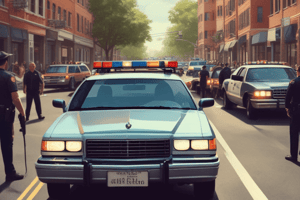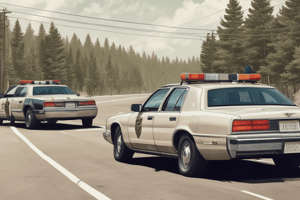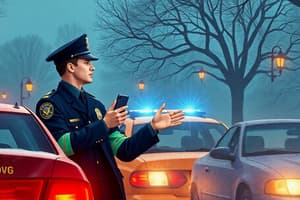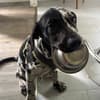Podcast
Questions and Answers
What is the primary goal of a traffic stop?
What is the primary goal of a traffic stop?
- To promote driver education and safer roadways (correct)
- To make an arrest
- To find someone who needs help
- To issue a uniform traffic citation or warning
How can you minimize negative and potentially unsafe results during a traffic stop?
How can you minimize negative and potentially unsafe results during a traffic stop?
- By conducting yourself professionally and following your training (correct)
- By rushing through the stop
- By being aggressive and confrontational
- By ignoring the driver's concerns
What should you do when greeting the driver and passengers during a traffic stop?
What should you do when greeting the driver and passengers during a traffic stop?
- Greet them politely and introduce yourself and your agency (correct)
- Start writing the citation immediately
- Be rude and dismissive
- Ask them to step out of the vehicle
Why should you describe the violation in terms of what you saw the vehicle do, rather than the driver?
Why should you describe the violation in terms of what you saw the vehicle do, rather than the driver?
What should you do when the driver is reacting with anger or fear during a traffic stop?
What should you do when the driver is reacting with anger or fear during a traffic stop?
What is an important aspect of maintaining officer safety during a traffic stop?
What is an important aspect of maintaining officer safety during a traffic stop?
What is a key aspect of exercising procedural justice during a traffic stop?
What is a key aspect of exercising procedural justice during a traffic stop?
Why should you allow the driver to talk or vent during a traffic stop?
Why should you allow the driver to talk or vent during a traffic stop?
What should be considered when planning a traffic stop?
What should be considered when planning a traffic stop?
Why is it important to become familiar with normal traffic flow in your assigned patrol zone?
Why is it important to become familiar with normal traffic flow in your assigned patrol zone?
What should an officer avoid when choosing a location for a traffic stop?
What should an officer avoid when choosing a location for a traffic stop?
Why should an officer check the width of the road and the shoulder?
Why should an officer check the width of the road and the shoulder?
What is a potential risk when stopping a vehicle in a populated area?
What is a potential risk when stopping a vehicle in a populated area?
When should an officer request backup during a traffic stop?
When should an officer request backup during a traffic stop?
Why should an officer avoid stopping a vehicle in an area with a merge zone?
Why should an officer avoid stopping a vehicle in an area with a merge zone?
Why should an officer prefer to stop a vehicle on a level spot or a slight downgrade?
Why should an officer prefer to stop a vehicle on a level spot or a slight downgrade?
What is the importance of periodically asking dispatch to provide the location and estimated time of arrival (ETA) for backup units?
What is the importance of periodically asking dispatch to provide the location and estimated time of arrival (ETA) for backup units?
What should an officer look for in an ideal stopping location during a high-risk traffic stop?
What should an officer look for in an ideal stopping location during a high-risk traffic stop?
Who usually serves as the primary officer during a high-risk traffic stop?
Who usually serves as the primary officer during a high-risk traffic stop?
What should an officer attempt to do when backup officers arrive during a high-risk traffic stop?
What should an officer attempt to do when backup officers arrive during a high-risk traffic stop?
Why is it important for the primary officer to direct responding patrol units to positions of backup or control during a high-risk traffic stop?
Why is it important for the primary officer to direct responding patrol units to positions of backup or control during a high-risk traffic stop?
What is a characteristic of a safe stopping location during a high-risk traffic stop?
What is a characteristic of a safe stopping location during a high-risk traffic stop?
What should an officer consider when choosing a location to conduct a high-risk traffic stop?
What should an officer consider when choosing a location to conduct a high-risk traffic stop?
What is a benefit of regular updates to dispatch during a high-risk traffic stop?
What is a benefit of regular updates to dispatch during a high-risk traffic stop?
When interacting with a driver, what is the first thing a law enforcement officer should do?
When interacting with a driver, what is the first thing a law enforcement officer should do?
What should a law enforcement officer observe when the driver reaches for the required documentation?
What should a law enforcement officer observe when the driver reaches for the required documentation?
Why should a law enforcement officer request the driver to remove the license from the wallet?
Why should a law enforcement officer request the driver to remove the license from the wallet?
What should a law enforcement officer do if the driver states they have a medical condition that explains the violation?
What should a law enforcement officer do if the driver states they have a medical condition that explains the violation?
What should a law enforcement officer display when interacting with the driver?
What should a law enforcement officer display when interacting with the driver?
When asking the driver for their documentation, what should a law enforcement officer ask?
When asking the driver for their documentation, what should a law enforcement officer ask?
What should a law enforcement officer explain to the driver during the stop?
What should a law enforcement officer explain to the driver during the stop?
Where might a driver typically retrieve their required documentation from?
Where might a driver typically retrieve their required documentation from?
What is the primary consideration when re-entering traffic after a traffic stop?
What is the primary consideration when re-entering traffic after a traffic stop?
When developing probable cause to justify an arrest during a traffic stop, what should you do?
When developing probable cause to justify an arrest during a traffic stop, what should you do?
What should you consider when deciding what to do with the vehicle and passengers after an arrest?
What should you consider when deciding what to do with the vehicle and passengers after an arrest?
Why should you treat passengers with dignity and respect during an arrest?
Why should you treat passengers with dignity and respect during an arrest?
What should you do with the vehicle if it is stolen?
What should you do with the vehicle if it is stolen?
When can you arrange for a third party to remove the driver's vehicle?
When can you arrange for a third party to remove the driver's vehicle?
What should you do before making an arrest during a traffic stop?
What should you do before making an arrest during a traffic stop?
What is a key consideration when dealing with passengers during an arrest?
What is a key consideration when dealing with passengers during an arrest?
Flashcards are hidden until you start studying
Study Notes
Communication With Drivers During Traffic Stops
- The goal of every traffic stop is to promote driver education and safer roadways.
- During traffic stops, you may issue a uniform traffic citation or warning, make an arrest, or find that someone needs help.
Decreasing Tension and Increasing Cooperation
- Exercise procedural justice and remain professional at all times.
- Greet the driver and passengers politely, introduce yourself and your agency, and tell them why you stopped them.
- Give the driver the chance to speak, request their driver's license, registration, and proof of insurance, and explain why you made the stop.
- Describe the violation in terms of what you saw the vehicle doing, not the driver.
- Allow the driver to talk or vent, remain polite and focused, conveying to the driver that you are listening to them.
- Keep a pleasant expression, a calm tone of voice, and a non-confrontational interview stance while maintaining officer safety.
- Establish a command presence by using words that convey professionalism and respect.
Planning the Stop
- Plan to conduct the stop in an area that gives the driver a place to stop safely, preferably in a well-lit location with a low traffic volume.
- Consider traffic flow when planning the traffic stop, including weather conditions, school zones, construction zones, and neighborhood activities.
- If you have an assigned patrol zone, become familiar with normal traffic flow, speed limits, and changes to traffic flow and conditions at different times of day.
- Choose a location where the driver can maneuver out of the flow of traffic, avoiding merge areas, intersections, and acceleration lanes.
Interacting with the Driver
- Begin by identifying yourself as a law enforcement officer, especially if you are not in uniform.
- Display a courteous but commanding presence, and you are less likely to encounter resistance.
- Make sure your expression, tone of voice, body position, gestures, and words are professional, respectful, and polite even while being assertive.
- Explain the reason for the stop, describing what you observed the vehicle doing, and request the required documentation.
- Allow the driver to offer an explanation, such as a vehicle malfunction, and take appropriate action if necessary.
Arrests During Traffic Stops
- During a traffic stop, you may develop probable cause to justify an arrest of a driver or a passenger for an offense that came to your attention during your investigation.
- Before making an arrest, call for backup and work together with the backup officer to conduct the arrest safely.
- Remember to maintain a professional standard of conduct at all times.
Disposition of the Vehicle and Passengers
- If you arrest a driver during a traffic stop, decide what to do with the vehicle and any passengers.
- Treat the passengers with dignity and respect, and be aware of their emotional reactions.
- Depending on the offense, you may search the vehicle, impound it, or retain it for evidence.
- Follow agency policies and procedures to inventory the contents of the vehicle and remove and secure any driver or passenger possessions.
Requesting and Waiting for Backup
- Periodically ask dispatch to provide the location and estimated time of arrival (ETA) for the backup units.
- An accurate ETA may help you plan for the safest stopping location.
- Identify a safe location to stop when backup officers arrive, considering factors such as lighting, traffic, pedestrians, and available space.
Coordinating With Other Officers
- The initiating officer usually serves as the primary officer, but there may be exceptions.
- Attempt to stop all vehicular and pedestrian traffic when backup officers arrive.
- Using the radio, the primary officer directs the responding patrol units to positions of backup or control of the driver and passengers.
- Backup officers should know what is expected of their positions to work safely and effectively as a team.
Studying That Suits You
Use AI to generate personalized quizzes and flashcards to suit your learning preferences.





